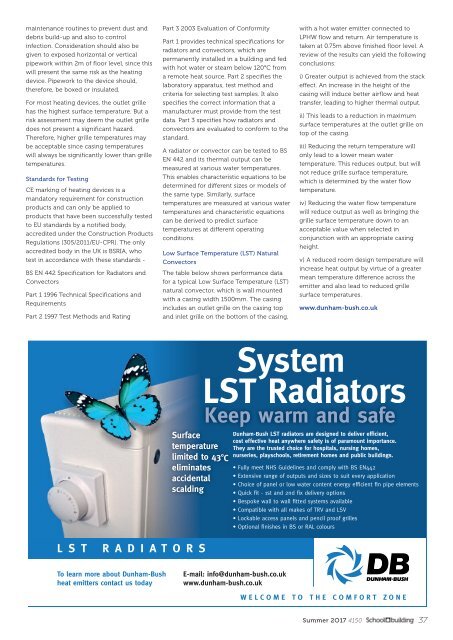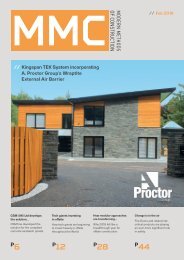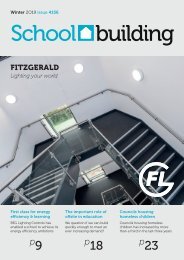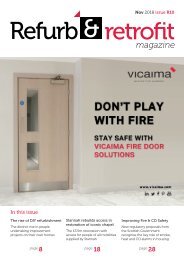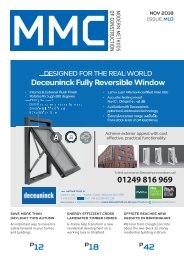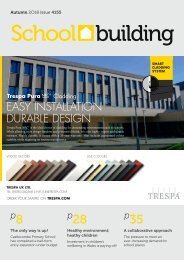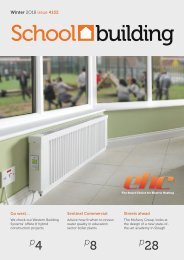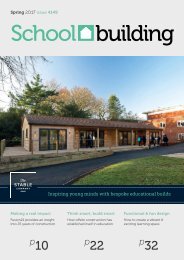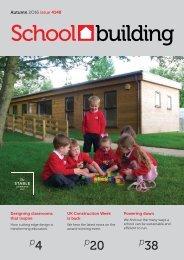SB 4150 Web
Create successful ePaper yourself
Turn your PDF publications into a flip-book with our unique Google optimized e-Paper software.
maintenance routines to prevent dust and<br />
debris build-up and also to control<br />
infection. Consideration should also be<br />
given to exposed horizontal or vertical<br />
pipework within 2m of floor level, since this<br />
will present the same risk as the heating<br />
device. Pipework to the device should,<br />
therefore, be boxed or insulated.<br />
For most heating devices, the outlet grille<br />
has the highest surface temperature. But a<br />
risk assessment may deem the outlet grille<br />
does not present a significant hazard.<br />
Therefore, higher grille temperatures may<br />
be acceptable since casing temperatures<br />
will always be significantly lower than grille<br />
temperatures.<br />
Standards for Testing<br />
CE marking of heating devices is a<br />
mandatory requirement for construction<br />
products and can only be applied to<br />
products that have been successfully tested<br />
to EU standards by a notified body,<br />
accredited under the Construction Products<br />
Regulations (305/2011/EU-CPR). The only<br />
accredited body in the UK is BSRIA, who<br />
test in accordance with these standards -<br />
BS EN 442 Specification for Radiators and<br />
Convectors<br />
Part 1 1996 Technical Specifications and<br />
Requirements<br />
Part 2 1997 Test Methods and Rating<br />
Part 3 2003 Evaluation of Conformity<br />
Part 1 provides technical specifications for<br />
radiators and convectors, which are<br />
permanently installed in a building and fed<br />
with hot water or steam below 120°C from<br />
a remote heat source. Part 2 specifies the<br />
laboratory apparatus, test method and<br />
criteria for selecting test samples. It also<br />
specifies the correct information that a<br />
manufacturer must provide from the test<br />
data. Part 3 specifies how radiators and<br />
convectors are evaluated to conform to the<br />
standard.<br />
A radiator or convector can be tested to BS<br />
EN 442 and its thermal output can be<br />
measured at various water temperatures.<br />
This enables characteristic equations to be<br />
determined for different sizes or models of<br />
the same type. Similarly, surface<br />
temperatures are measured at various water<br />
temperatures and characteristic equations<br />
can be derived to predict surface<br />
temperatures at different operating<br />
conditions.<br />
Low Surface Temperature (LST) Natural<br />
Convectors<br />
The table below shows performance data<br />
for a typical Low Surface Temperature (LST)<br />
natural convector, which is wall mounted<br />
with a casing width 1500mm. The casing<br />
includes an outlet grille on the casing top<br />
and inlet grille on the bottom of the casing,<br />
with a hot water emitter connected to<br />
LPHW flow and return. Air temperature is<br />
taken at 0.75m above finished floor level. A<br />
review of the results can yield the following<br />
conclusions:<br />
i) Greater output is achieved from the stack<br />
effect. An increase in the height of the<br />
casing will induce better airflow and heat<br />
transfer, leading to higher thermal output.<br />
ii) This leads to a reduction in maximum<br />
surface temperatures at the outlet grille on<br />
top of the casing.<br />
iii) Reducing the return temperature will<br />
only lead to a lower mean water<br />
temperature. This reduces output, but will<br />
not reduce grille surface temperature,<br />
which is determined by the water flow<br />
temperature.<br />
iv) Reducing the water flow temperature<br />
will reduce output as well as bringing the<br />
grille surface temperature down to an<br />
acceptable value when selected in<br />
conjunction with an appropriate casing<br />
height.<br />
v) A reduced room design temperature will<br />
increase heat output by virtue of a greater<br />
mean temperature difference across the<br />
emitter and also lead to reduced grille<br />
surface temperatures.<br />
www.dunham-bush.co.uk<br />
Surface<br />
temperature<br />
limited to 43 o C<br />
eliminates<br />
accidental<br />
scalding<br />
LST RADIATORS<br />
System<br />
LST Radiators<br />
Keep warm and safe<br />
Dunham-Bush LST radiators are designed to deliver efficient,<br />
cost effective heat anywhere safety is of paramount importance.<br />
They are the trusted choice for hospitals, nursing homes,<br />
nurseries, playschools, retirement homes and public buildings.<br />
• Fully meet NHS Guidelines and comply with BS EN442<br />
• Extensive range of outputs and sizes to suit every application<br />
• Choice of panel or low water content energy efficient fin pipe elements<br />
• Quick fit - 1st and 2nd fix delivery options<br />
• Bespoke wall to wall fitted systems available<br />
• Compatible with all makes of TRV and LSV<br />
• Lockable access panels and pencil proof grilles<br />
• Optional finishes in BS or RAL colours<br />
To learn more about Dunham-Bush<br />
heat emitters contact us today<br />
E-mail: info@dunham-bush.co.uk<br />
www.dunham-bush.co.uk<br />
WELCOME TO THE COMFORT ZONE<br />
Summer 2O17 <strong>4150</strong> 37


